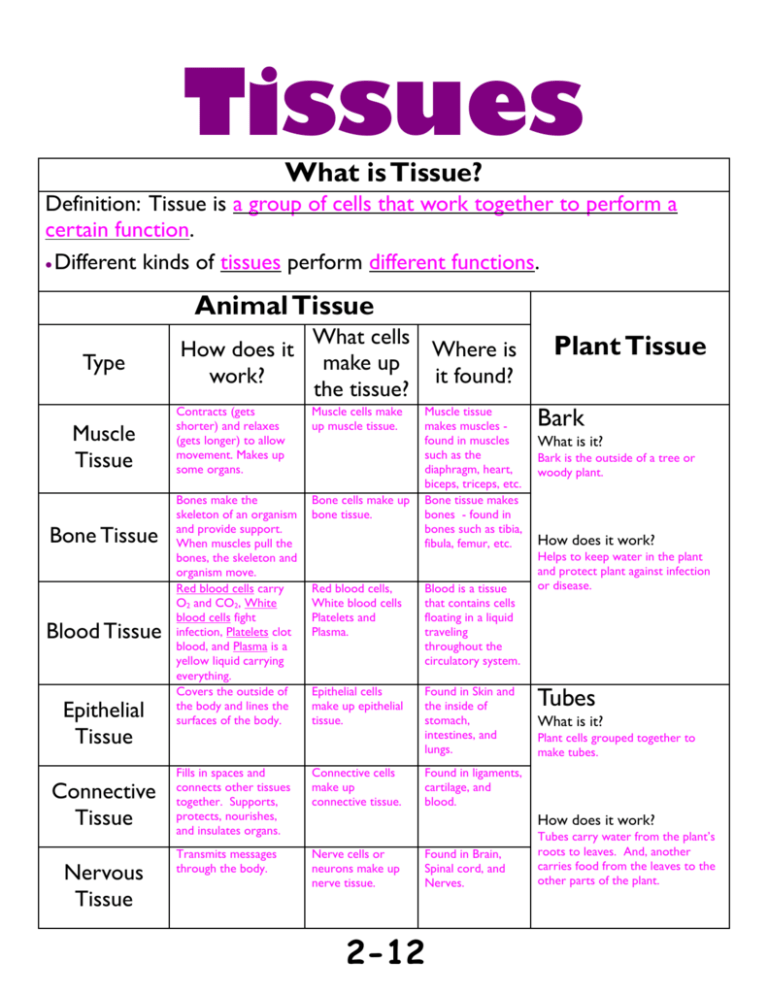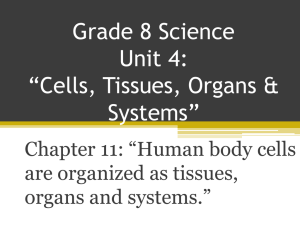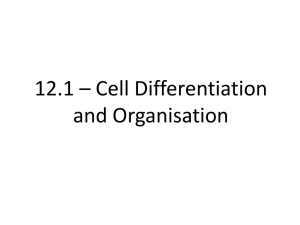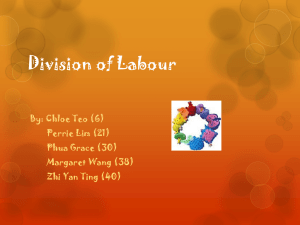What is Tissue? - Lisle CUSD 202
advertisement

Tissues What is Tissue? Definition: Tissue is a group of cells that work together to perform a certain function. Different kinds of tissues perform different functions. Animal Tissue Type Muscle Tissue Bone Tissue Blood Tissue Epithelial Tissue Connective Tissue Nervous Tissue How does it work? What cells Where is make up it found? the tissue? Contracts (gets shorter) and relaxes (gets longer) to allow movement. Makes up some organs. Muscle cells make up muscle tissue. Bones make the skeleton of an organism and provide support. When muscles pull the bones, the skeleton and organism move. Red blood cells carry O2 and CO2, White blood cells fight infection, Platelets clot blood, and Plasma is a yellow liquid carrying everything. Covers the outside of the body and lines the surfaces of the body. Bone cells make up bone tissue. Muscle tissue makes muscles found in muscles such as the diaphragm, heart, biceps, triceps, etc. Bone tissue makes bones - found in bones such as tibia, fibula, femur, etc. Red blood cells, White blood cells Platelets and Plasma. Blood is a tissue that contains cells floating in a liquid traveling throughout the circulatory system. Epithelial cells make up epithelial tissue. Found in Skin and the inside of stomach, intestines, and lungs. Fills in spaces and connects other tissues together. Supports, protects, nourishes, and insulates organs. Connective cells make up connective tissue. Transmits messages through the body. Nerve cells or neurons make up nerve tissue. Plant Tissue Bark What is it? Bark is the outside of a tree or woody plant. How does it work? Helps to keep water in the plant and protect plant against infection or disease. Tubes What is it? Plant cells grouped together to make tubes. Found in ligaments, cartilage, and blood. How does it work? Found in Brain, Spinal cord, and Nerves. 2-12 Tubes carry water from the plant’s roots to leaves. And, another carries food from the leaves to the other parts of the plant. Organs What is an Organ? Definition: An Organ is different kinds of tissues grouped together (to form organs). Different kinds of organs perform different functions. Animal Organs Plant Organs In the boxes below, describe the different In the boxes below, describe the different tissues found in the organ and the organs jobs. tissues found in the organ and the organs jobs. Heart Leaves What tissues are in this organ? What types of tissues are in this organ? What do the tissues do? The heart contains blood, muscle (cardiac), connective, epithelial, & nervous tissues. How does it work? The nerves send messages from the brain to tell the heart to contract and relax. Pump bloods when the muscle contracts and relaxes from the heart to the blood vessels which are made of connective and epithelial tissues. 1. 2. 3. Tissues that make food. Tissues that give shape. Tissues that form waxy material that coats leaves and protects leaves from drying out. Lungs Stems What tissues are in this organ? What types of tissues are in this organ? What do the tissues do? Lungs contain blood, muscle (smooth), connective, epithelial, & nervous tissues. The tissues form a bag, tubes, sacs, and vessels. How does it work? The nerves send messages from the brain to tell the diaphragm to contract and relax. The diaphragm muscle pulls the lungs causing air to be sucked in, and relaxes to have air rushing out. The lungs take in oxygen which travels through connective tissue to blood. The blood releases waste to the connective tissue of the lungs as well. 1. 2. 3. Tissues that are firm that holds the leaves up to sunlight. Tissues move water and other materials. Tissues move food from the leaves to other parts of the plant. Stomach Roots What tissues are in this organ? What types of tissues are in this organ? What do the tissues do? Stomach contain blood, muscle (smooth), connective, epithelial, & nervous tissues. How does it work? The nerves send messages from the brain to tell the stomach muscle to contract and relax which mixes the food. Tissues in the lining of the stomach produce chemicals that break food down. The food particles travel through connective tissue to blood so that the body’s cells receive nutrients. 1. 2. 3. 2-13 Tissues that take in water and other materials from the soil. Tissues that hold the plant in the soil. Tissues that store extra food for the plant.








